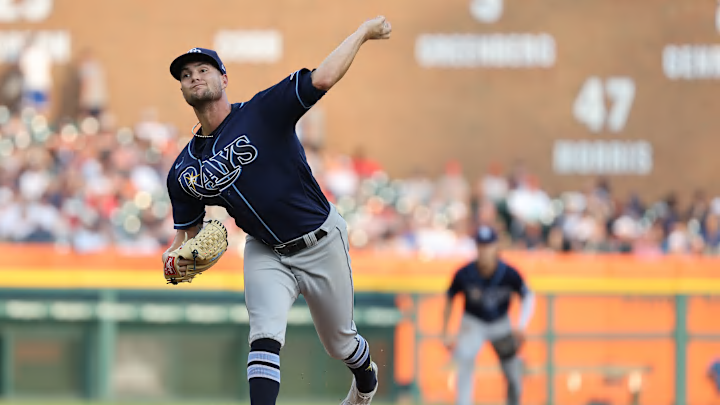Tampa Bay Rays ace Shane McClanahan is having a fantastic breakout year despite a mini-slump as of late. After back-to-back starts of allowing 4 earned runs or more, his ERA has swelled to 2.24 from the 1.76 it was at just a couple of weeks ago. That's obviously still an elite number as far as ERA goes, but the increase has been enough to unseat him from the lead in the AL Cy Young race, a position that he held for nearly the entire first half of the season. Justin Verlander and Dylan Cease have since jumped ahead of him on the ERA leaderboard, as has Martin Perez on the rWAR leaderboard.
There is some good news, however, for McClanahan and the Rays despite his past couple of starts not living up to his standards. Plenty of indicators suggest that he has been the victim of some bad luck more than he has been a bad pitcher of late.
Two outings ago against the Guardians, McClanahan took the loss after giving up 5 earned runs on 7 hits through 4.1 innings. The only real criticism that can be laid against him for that start is the fact that he walked 3 batter, as he was generating the type of contact that should turn into outs. Despite allowing 7 hits, he only gave up a single hard-hit ball (per Statcast), and it was beaten into the ground for a force out.
On the flip side, he was lit up for a .362 expected batting average and 9 hard hits against during his start versus the Tigers on Saturday, so in actuality, he has only had one poor start recently. Ironically, it came against a team that is on pace for a historically bad season offensively. Looking outside of his outing against Cleveland, there is evidence that McClanahan has been unlucky even when he has been dominating this year.
At first glance, not much separates McClanahan from the other dominant starters in baseball: plenty of innings and strikeouts, few walks, and a low ERA. There is one stat, though, that's fairly anomalous. 15.6% of the flyballs he has surrendered this year have led to home runs. That's a lot, especially for someone who excels at generating weak contact. Out of 60 qualified starting pitchers in 2022, McClanahan's HR/FB% is the 5th-highest. This conveys that his 0.98 HR/9, which ranks exactly 30th, should be farther away from league-average and closer to elite.
FIP has become a mainstream statistic in recent years. It's an ERA estimator based on strikeouts, walks, and home runs. xFIP, its "sister stat", is less used. xFIP shows what a pitcher's FIP "should" be based on the rate of flyballs he allows. If a player allows very few home runs but gives up a lot of flyballs, his ERA and FIP will be lower than his xFIP, which would suggest that his results are unsustainable.
There are limitations to using xFIP since pitchers sometimes try to generate weak flyballs on purpose, but because McClanahan is more of a strikeout pitcher, it's applicable in this case. His FIP in 2022 is 2.60, but his xFIP is a much better 2.23. For comparison's sake, San Francisco's Carlos Rodon has a FIP of 2.27, almost identical to McClanahan's xFIP. Rodon has been worth a full win more than McClanahan has according to Fangraphs (Rodon's fWAR is 2nd among pitchers in MLB), yet the two have thrown the exact same amount of innings.
Statcast backs up this point of view as well. Despite his unnaturally bloated HR/FB%, McClanahan's exit velocity on flyballs and line drives is 92.5 MPH, which is better than average. Statcast also tracks expected home runs based on distance and velocity relative to each park's unique dimensions, and McClanahan may have given up 14 homers so far in 2022, but he only has 12.6 expected home runs against. Even detracting just a solo shot from his record would lower his season ERA by 7 points.
Shane McClanahan, in the midst of a Cy Young-caliber season, has given up more home runs than he has deserved, and his already-outstanding results should be even better. In all likelihood, this "slump" he is in will turn out to be the most minor of setbacks in an unbelievable season.
